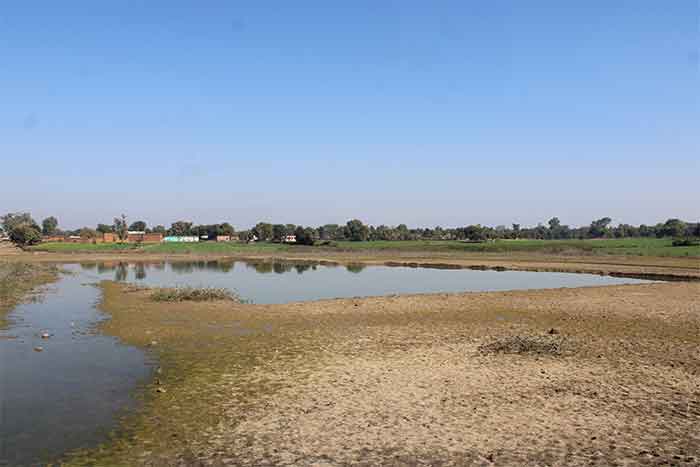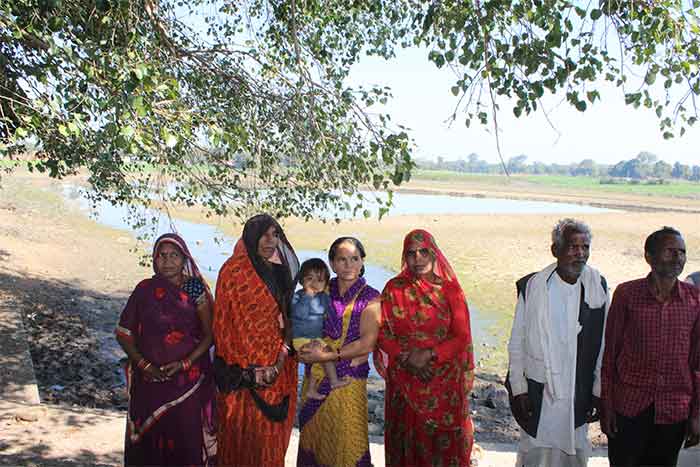
In Bundelkhand region of Central India water tanks have constituted a very important component of efforts of communities to meet the water needs of people over the centuries. In particular the period of Chandela and Bundela rulers from 9th to 18th century has been identified as a time when royal patronage was extended to communities for creation of several thousand such structures, many of which are still admired for the wisdom of communities which helped to create these water-bodies with a very sound understanding of local conditions.
With a thorough understanding of the importance of these tanks these communities contributed to their proper maintenance and protection for a long time. With the advent of colonial rule, however, community efforts suffered in many ways. Apart from neglect of maintenance, encroachments in water retention and catchment areas also contributed to deterioration of tanks. Another factor of recent times was mistaken interpretation of government rules which became an obstacle for any community initiative to take up periodic de-silting of tanks. As deforestation and soil-erosion in catchment areas worsened at several places, the siltation of tanks also increased and their capacity to meet water needs of villagers and animals was badly eroded.
It was at this stage that a voluntary organization SRIJAN started discussing the possibilities of taking up de-siltation work with several rural communities. This effort was helped by the studies conducted by the ABV Institute for Good Governance and Policy Analysis (IGG).
Discussions with communities revealed that this work had their strong support. While this work was envisaged mainly as an effort for increasing the water availability and water holding capacity of tanks, farmers were also found to be very enthusiastic regarding the improvement of the fertility of their fields as a result of deposition of fertile silt there. Hence many of them came forward to meet the costs of transporting the removed silt.

Manpokhar, a tank in Lakhaipur village of Tikamgarh district ( Madhya Pradesh) was one of several tanks which was subsequently taken up for de-silting. Recently when I met several villagers here, they were full of praise for this effort.
Ramdevi, a well-informed and articulate woman farmer said pointing towards the tank (this can be seen in the accompanying photo also)—Look at the tank there. There is still plenty of water in January while this was not the case earlier. However the patch which was not de-silted has dried up as before.
She adds—This work is a big blessing particularly for our animals as well as for those roaming around loose. They can quench their thirst here now.
However Harbhajan, another farmer, emphasizes the gains made to fertility of fields even more. “When we deposited the the fertile silt in our fields, the yield increased significantly”, he says.
While the deposition of silt was a one-time affair, more sustained gains to farm productivity accrued from the recharging of wells contributed by the presence of more water in the tank and what is more, its longer-term availability. If with more and continuing efforts, the year round presence of water in the tank can be ensured on a sustainable basis, this will make the gain more permanent.
Ashish Ambasta, who has been closely involved in several such efforts in neighboring district of Nivari, says that three benefits are very clearly visible—the immediate gains from deposition of fertile silt, the longer-term benefits of improved recharge of water in fields, and the better availability of water for direct human and animal needs. He particularly mentions the efforts of a woman community leader Shashi Prajapati who played a very important role in mobilizing community efforts for the success of de-silting work in Kudar villge, resulting in almost year-round availability of water in a tank there.
Hence Ram Devi pleads for more silt removal again in her village this year. However SRIJAN team leader Rakesh Singh cautions that they have to distribute their limited resources more evenly so that villages whose need is the greatest can be covered on a priority basis. Besides, he emphasizes that several precautions have to be ensured like leaving the lower layers of silt undisturbed. Project member Mangal Singh adds that special care has to be taken to protect the bund. If precautions are not observed, then unintended harm can also result. This is an additional reason for making this a community effort. Additional fertile silt for fields can be obtained also by creating a silt-trap which involves only a minor addition to the entire de-silting work.
Project Manager Kamlesh Kurmi emphasizes two aspects of community mobilization in this entire effort. Firstly, farmers should be willing to spend their own resources for carrying the fertile silt from tank to their fields. Secondly, despite the meager capacity of marginal and poorest farmers, somehow it should be ensured in community meetings that they get their fair share of the fertile silt. Hence, Rakesh Singh adds that while the organization does not at all have the resources to cover the transport costs for all farmers, they try quietly to provide some help to the poorest among them, particularly those from marginalized communities like scheduled tribes and scheduled castes, so that they too can get the removed fertile silt. Another priority group should be the potter artisans who have been passing through very difficult times.
When this work taken up in Tikamgarh gave promising results, this was spread to other districts of Bundelkhand region like Mahoba and Chitrakut ( Uttar Pradesh) and Nivari( Madhya Pradesh) as well as other places with the help of activists and organizations working there . However there is much more scope for extending this work. A study on rejuvenation of traditional water bodies prepared by the IGG says, citing Irrigation Department sources, says that there are 995 Chandela tanks in Tikamgarh district alone out of which nearly 100 are used for irrigation. Hence the potential of using this de-silting as a means of increasing water holding capacity of tanks as well as improving farm productivity is huge in the entire Bundelkhand region as well as other areas where there are many tanks which have not been de-silted for a long time and hence have a huge over-burden of silt. As a cost-effective means of improving water-storage as well as farm productivity, community based de-siltation work taken up with all due precautions can play an important role in several areas.
Bharat Dogra is Honorary Convener, Campaign to Save Earth Now. His recent books include Planet in Peril, Protecting Earth for Children and A Day in 2071.















































